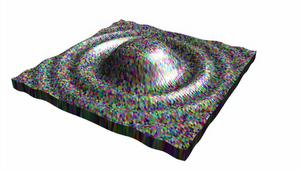Information
- Publication Type: Bachelor Thesis
- Workgroup(s)/Project(s):
- Date: March 2022
- Date (Start): 10. September 2017
- Date (End): 18. March 2022
- Matrikelnummer: 00825724
- First Supervisor: Eduard Gröller
Abstract
In education and teaching, the way a topic or a concept is presented can be an important factor in how easily and thoroughly it can be grasped by students. The goal of this thesis project is to make a complex subject tangible, in this case the three-dimensional appearance of a mathematical term describing a certain topology and the way it is shaped by its parameters. The approach involves 3D-fabrication of such artefacts in an attempt at providing a helpful tool to comprehend the peculiarities of such objects. A software program was created to preview and manipulate topological objects from their parameterized representations as part of this thesis. Once the shape resembles the intentions of the user, the data can be exported in a format that is suitable for further processing and finally “3D-printing”. The proof-of-concept software as well as other auxiliary tools described in this document can be used to produce physical 3D-artefacts of the described models. While it might be seen as a starting point to elaborate further on this topic, some issues become apparent throughout each of the steps leading from the selection of the object, the preparation before fabrication all the way to the real-world artefacts that were created. Any future work might want to consider these issues and possibly find better solutions to work around given limitations, and maybe find inspiration in the suggested propositions.Additional Files and Images
Weblinks
No further information available.BibTeX
@bachelorsthesis{Staudacher_2022,
title = "3D-Printing to Understand Complex Topologies",
author = "Florian Staudacher",
year = "2022",
abstract = "In education and teaching, the way a topic or a concept is
presented can be an important factor in how easily and
thoroughly it can be grasped by students. The goal of this
thesis project is to make a complex subject tangible, in
this case the three-dimensional appearance of a mathematical
term describing a certain topology and the way it is shaped
by its parameters. The approach involves 3D-fabrication of
such artefacts in an attempt at providing a helpful tool to
comprehend the peculiarities of such objects. A software
program was created to preview and manipulate topological
objects from their parameterized representations as part of
this thesis. Once the shape resembles the intentions of the
user, the data can be exported in a format that is suitable
for further processing and finally “3D-printing”. The
proof-of-concept software as well as other auxiliary tools
described in this document can be used to produce physical
3D-artefacts of the described models. While it might be seen
as a starting point to elaborate further on this topic, some
issues become apparent throughout each of the steps leading
from the selection of the object, the preparation before
fabrication all the way to the real-world artefacts that
were created. Any future work might want to consider these
issues and possibly find better solutions to work around
given limitations, and maybe find inspiration in the
suggested propositions.",
month = mar,
address = "Favoritenstrasse 9-11/E193-02, A-1040 Vienna, Austria",
school = "Research Unit of Computer Graphics, Institute of Visual
Computing and Human-Centered Technology, Faculty of
Informatics, TU Wien ",
URL = "https://www.cg.tuwien.ac.at/research/publications/2022/Staudacher_2022/",
}

 Bachelor thesis
Bachelor thesis Image
Image

